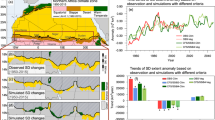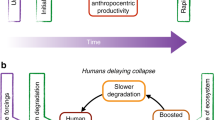Abstract
The knowledge of the history of regional geosystems and prediction of their future evolution trends are indispensable for nature conservation. Global warming threatens to become catastrophic and is thus an urgent scientific and social problem. The last century of the past millennium was marked by an exceptional growth of global air temperature which became 0.6° higher than at the end of the Little Ice Age (1550-1850). Warming was especially rapid after the 1960s, with a linear trend of 0.20° C per decade (global) and 0.29° C per decade in the Northern Hemisphere (Grusa et al., 2001). The past decade was the warmest over the millennium, and 1998 was the globally warmest year. Arctic ice sheets in warm season have reduced in surface area for 10-15% and have become 40% thinner for the past 50 yr. Mountain glaciers in Asia have been reducing and permafrost has been degrading. Scientists are not unanimous about the prospects, some believing that warming-related global change can speed up and cause regional- and global-scale socioeconomic ill effects, and others considering the problem ambiguous and poorly understood; the latter opinion is that prediction has even increased in uncertainty lately instead of being resolved (Boehmer- Christiansen, 2000). Prediction for global change and its short-term consequences is difficult because the changes are driven by sophisticated interplay of numerous climate controls and feedback mechanisms, while the available field and modeling data remain insufficient. The relative contributions of natural and cultural effects to the ongoing warming have not been so far constrained unambiguously.
Access this chapter
Tax calculation will be finalised at checkout
Purchases are for personal use only
Preview
Unable to display preview. Download preview PDF.
Similar content being viewed by others
REFERENCES
Bassinot F.C., Labeyrie L.D., Vincent E., Quidelleur X., Shackleton N.J., Lancelot Y. (1994) The astronomical theory of climate and the age of the Brunhes-Matuyama magnetic reversal. Earth and Planetary Science Letters, vol. 126, p. 91–108.
Bazarov D.D.B. (1986) The Cenozoic of the Baikal and western Trans-Baikal regions. Nauka, Novosibirsk, 180 pp. (in Russian).
Bezrukova E.V., Bogdanov Y.A., Williams D.F., Granina L.Z., Grachev M.A., Ignatova N.V., Karabanov E.B., Kuptsov V.M., Kurylev A.V., Letunova P.P., Likhoshvay E.V., Chernyaeva G.P., Shimaraeva M.K. and Yakushin A.O. (1991) A dramatic change in the ecosystem of Lake Baikal in the Holocene. Doklady Akademii Nauk SSSR, 321, 1032–1037. (in Russian).
Biscaye P.I., Crousset F.E., Revel M., Van der Gaast S., Zielinski G.A., Vaars A., Kukla G. (1997) Asian provenance of glacial dust (stage 2) in the Greenland Ice Sheet Project 2 Ice Core,Summit, Greenland. J. Geophys. Res., 102, pp. 26765–26781.
Boehmer-Christiansen S. (2000) Who and how makes the policy concerning global change. Izvestia Russian Geographical Society, 132, 3, pp. 6–22. (in Russian).
Borzenkova I.I. (1987) Land wetting in the Northern Hemisphere in the geological past. Meteorology and hydrology, 10, pp. 53–61. (in Russian).
Borzenkova I.I. (1992) Climate change in the Cenozoic. Hydrometeoizdat, St. Petersburg, 248 pp. (in Russian).
Broecker W.S. (2000) Abrupt climate change: causal constraints provided by the paleoclimate record. Earth-Science Reviews, 51, pp. 137–154.
Chichagov V.P. (1996) Arid peneplain of Central Asia and its formation in the Little Ice Age in Eastern Mongolia. Izvestia Russian Geographical Society, 6, pp. 28–38. (in Russian).
Climate Change 2001: The Science of Climate Change. Intergovernmental Panel on Climate Change. J.T.Houghton et al. (Eds). Cambridge University Press. Cambridge. 2001. 881 pp.
Colman S.M., Peck J.A., Karabanov E.B., Carter S.J., Bradbury J.P., King J.W. and Williams D.F. (1995) Continental climate response to orbital forcing from biogenic silica records in Lake Baikal. Nature, 378, 769–771.
Dobretsov N.L., Zykin V.S., Zykina V.S. (2003) Structure of the Pleistocene Loess-Soil Sequence of Western Siberia and Its Correlation with the Baikalian and Global Records of Climatic Change. Doklady Earth Sciences, 391A, pp. 921–924.
Drozdov O.A. (1981) Land moistening and climate change. Meteorology and hydrology, 4, pp. 17–28. (in Russian).
Fairbridge Rh.W. (1989) Water deficiency versus water excess: global management potential. In Paepe R., Fairbrdge Rh.W., Jelgersma S. (eds.) Greenhouse Effect, Sea Level and Drought. NATO ASI Series. Series C. Vol. 325. Kluwer Academic Publishers, Dordrecht, Boston, London, pp. 185–197.
Gavshin V.M., Bobrov V.A., Khlystov O.K. (2001) Periodicity in diatom sedimentation and geochemistry of diatomaceous mud in Lake Baikal: global aspect. Russian Geology and Geophysics, 42, pp. 317–325.
Goldberg E.L., Phedorin M.A., Grachev M.A., Bobrov V.A., Dolbnya I.P., Khlystov O.M., Levina O.V., Ziborova G.A. (2000) Geochemical signals of orbital forcing in the records of paleoclimates found in the sediments of Lake Baikal. Nucl. Instr. and Meth. in Phys. Res. A., 448, 1–2, pp. 384–393.
Goldberg E.L., Chebykin E.P., Vorobyeva S.S., Grachev M.A. (2005) Uranium signals of paleoclimate humidity recorded in sediments of Lake Baikal. Doklady Earth Sciences, 400, 1, pp. 52–56.
Grachev M.A., Gorshkov A.G., Azarova I.N., Goldberg E.L., Vorob’eva S.S., Zheleznyakova T.O., Bezrukova E.V., Krapivina S.M., Letunova P.P., Khlystov O.K., Levina O.V., Chebykin E.P. (2002) Regular climate oscillations in millennial-scale speciation in Lake Baikal. Major regularities of global and regional climatic and environmental changes in the Late Cenozoic of Siberia. E.A.Vaganov et al. (Eds). Institute of Archaeology and Ethnography SB RAS Press, Novosibirsk, pp. 107–121. (in Russian).
Gruza G.V., Bardin M.Yu., Ran’kova E.Ya., Rocheva E.V., Sokolov Yu.Yu., Samokhina O.F., Platova T.V. (2001) On air temperature and precipitation changes in the territory of Russia during the 20th century. In Integrated monitoring of the environment and climate. Limits of change. Yu.A.Izrael (Ed.), Nauka, Moscow, pp. 18–39. (in Russian).
Jones P.D., Reid P.A. (2001) Temperature trends in regions affected by increasing aridity/humidity // Geophysical Research Letters, 28, 20, pp. 3919–3922.
Karabanov E.B., Prokopenko A.A., Kuzmin M.I., Williams D., Gvozdkov A.N. and Kerber E.V. (2001) Glacial and interglacial periods of Siberia: the Lake Baikal paleoclimate record and correlation with West Siberian stratigraphic scheme (the Brunhes Chron). Russian Geology and Geophysics, 42, 1, pp. 41–54.
Karte J. (1987) Periglacial Phenomena and their Significance as Climatic and Edaphic Indicators. Geojournal, 7, 4, pp. 329–340.
Kovda V.A. (1977) Aridization of land and drought mitigation. Nauka, Moscow, 270. (in Russian).
Khotinsky N.A. (1989) Problems of reconstruction and correlation of Holocene paleoclimates. In Khotinsky N.A. (Ed.) Paleoclimates of the Late Glacial and Holocene. Nauka, Moscow, pp. 12–17. (in Russian).
Kukla G., An Z.S., Melice J.L., Gavin J., Xiao J.L. (1990) Magnetic susceptibility record of Chinese Loess. Transactions of the Royal Society of Edinburg. Earth Sci., 81, pp. 263–288.
Kutzbach J., Gallimore R., Harrison S., Behling P., Selin R., Laarif T. (1998) Climate and biome simulations for the past 21,000 years. Quaternary Science Reviews, 17, pp. 473–506.
Kuzmin M.I., Karabanov E.B., Kawai T., Williams D., Bychinsky V.A., Kerber E.V., Kravchinsky V.A., Bezrukova E.V., Prokopenko A.A., Geletii V.F., Kalmychkov G.V., Goreglyad A.V., Antipin V.S., Khomutova M.Yu., Soshina N.M., Ivanov E.V., Khursevich G.K., Tkachenko L.L., Solotchina E.P., Ioshida N. and Gvozdkov A.N. (2001) Deep drilling on Lake Baikal: main results. Russian Geology and Geophysics, 42, 1, pp. 3–28.
Levina T.P., Orlova L.A. (1993) Holocene climatic rhythms of southern West Siberia. Russian Geology and Geophysics, 34, 3, pp. 36–51.
Lisitzin A.P. (1966) Main regularities in the distribution of recent siliceous sediments and their relations with climatic zonality. Geochemistry of Silica. N.M.Strakhov (Ed.). Nauka, Moscow, pp. 90–191. (in Russian).
Manabe S., Broccoli A.J. (1990) Mountains and Arid Climates of Middle Latitudes. Science, 247, pp. 192–195.
Monin A.S., Shishkov Yu.A. (1998) On Statistical Characteristics of the Little Ice Age. Doklady Akademii Nauk SSSR, 358, 2, pp. 252–255. (in Russian).
Petit J. R., Jouzel J., Raynaud D., Barkov N.I., Barnola J.-M., Basile I., Bender M., Chappellaz J., Davis M., Delaygue G., Delmotte M., Kotlyakov V.M., Legrand M., Lipenkov V.Y., Lorius C., Pépin L., Ritz C., Saltzman E., Stievenard M. (1999) Climate and atmospheric history of the past 420,000 years from the Vostok ice core, Antarctica. Nature, 399, pp. 429–436.
Prokopenko A.A., Karabanov E.B., Williams D.F., Kuzmin M.I., Shackleton N.J., Crowhurst S.J., Peck J.A., Gvozdkov A.N., King J.W. (2001) Biogenic silica record of the Lake Baikal response to climatic forcing during the Brunhes. Quaternary Research, 55, pp. 123–132.
Pulsating Lake Chany (1982). N.P.Smirnova, A.V. Shnitnikov (Eds). Nauka, Leningrad, 304 pp. (in Russian).
Shimaraev M.N., Granin N.G., Kuimova L.N. (1995) Experience of reconstruction of Baikal hydrophysical conditions in the Late Pleistocene and Holocene. Russian Geology and Geophysics, 36, 8, pp. 94–99.
Shnitnikov A.V. (1957) Humidity changes in the continental Northern Hemisphere. Transactions, USSR Geographical Society, New Series. T. 16. Moscow, Leningrad, Academy Science Press, 337 pp. (in Russian).
Velichko A.A. (1989) Holocene as element of the planetary natural process. In Khotinsky N.A. (ed.) Paleoclimates of the Late Glacial and Holocene. Nauka, Moscow, pp. 5–12. (in Russian).
Velichko A.A., Barash M.S., Grichuk V.P., Gurtovaya E.E., Zelikson E.M. (1984) The climate of the northern hemisphere in the epoch of the last Mikulino interglacial. Proceedings of the USSR Academy of Sciences. Geographical series, 1, pp. 5–18. (in Russian).
Verkhozina V.A., Kozhova J.M., Kusner Y.S. (1997) Hydrodynamics as a limiting factor in Lake Baikal ecosystem. Ecovision, 6, pp. 73–83.
Volkov I.A. (1976) The role of eolian factor in the topography evolution. In Timofeev D.A. (ed.) Problems of exogenic topography formation. Book 1. Nauka, Moscow, pp. 264–269.
Volkov I.A., Zykina V.S. (1991) Cyclicity of subaerial deposits of West Siberia and the Pleistocene climate history. In Zakharov V.A. (Ed.) Climatic Evolution, Biota and Envinronments of Man in the Late Cenozoic of Siberia. Institute of Geology, Geophysics and Mineralogy SB AN USSR, Novosibirsk, pp. 40–51. (in Russian).
Volkova V.S., Bakhareva V.A., Levina T.P. (1989) Vegetation and climate of Holocene of West Siberia. In Khotinsky N.A. (Ed.) Paleoclimates of the Lateglacial and Holocene. Nauka, Moscow, pp. 90–95. (in Russian).
Williams D.F., Peck J., Karabanov E.B., Prokopenko A.A., Kravchinsky V., King J., Kuzmin M.I. (1997) Lake Baikal Record of Continental Climate Response to Orbital Insolation During the Past 5 Million Years. Science, 278, pp. 1114–1117.
Zander A., Frechen M., Zykina V., Boenigk W. (2003) Luminescence chronology of the Upper Pleistocene loess record at Kurtak in Middle Siberia. Quaternary Science Reviews, 22, pp. 999–1010.
Zykin V.S., Zazhigin V.S., Zykina V.S. (1995) Changes in Environment and Climate during Early Pliocene in the Southern West-Siberian Plain. Russian Geology and Geophysics, 36, 8, pp. 37–47.
Zykin V.S., Zykina V.S., Orlova L.A. (2000a) Stratigraphy and major regularities of environmental and climatic changes in the Pleistocene and Holocene of Western Siberia. Archaeology, ethnology and anthropology of Eurasia, 1, pp. 3–22.
Zykin V.S., Zykina V.S., Orlova L.A. (2000b) Quaternary warming stages in Southern West Siberia: environment and climate. Russian Geology and Geophysics, 41, 3, pp. 295–312.
Zykin V.S., Zykina V.S., Orlova L. (2003) Reconstruction of environmental and climatic change during the Late Pleistocene in southern West Siberia using data from the Lake Aksor Basin. Archaeology, ethnology and anthropology of Eurasia, 4, pp. 2–16.
Zykina V.S. (1999) Pedogenesis and climate change history during Pleistocene in Western Siberia. Anthropozoikum, 23, pp. 49–54.
Zykina V.S., Volkov I.A., Dergachtva M.I. (1987) Upper Quaternary deposits and fossil soils of Novosibirsk Priobie. Nauka, Moscow, 204 pp.
Zykina V.S., Volkov I.A., Semenov V.V. (2000) Reconstruction of Neopleistocene climates in West Siberia based on study of Belovo key section. In: Problems of reconstruction of Holocene and Pleistocene Climate and Environment in Siberia. E.A.Vaganov et al. (Eds). Institute of Archaeology and Ethnography SB RAS Press, Novosibirsk, pp. 229–249.
Author information
Authors and Affiliations
Editor information
Editors and Affiliations
Rights and permissions
Copyright information
© 2006 Springer
About this paper
Cite this paper
DOBRETSOV, N., ZYKIN, V., ZYKINA, V. (2006). DESERTIFICATION OF MID-LATITUDE NORTHERN ASIA AND GLOBAL CHANGE PERIODICITY IN THE QUATERNARY. In: Vogtmann, H., Dobretsov, N. (eds) Environmental Security and Sustainable Land Use - with special reference to Central Asia. NATO Security through Science Series. Springer, Dordrecht. https://doi.org/10.1007/1-4020-4493-3_1
Download citation
DOI: https://doi.org/10.1007/1-4020-4493-3_1
Publisher Name: Springer, Dordrecht
Print ISBN: 978-1-4020-4491-5
Online ISBN: 978-1-4020-4493-9
eBook Packages: Earth and Environmental ScienceEarth and Environmental Science (R0)




